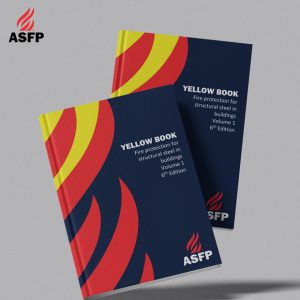 The Association for Specialist Fire Protection (ASFP) has launched the 6th Edition of the Yellow Book: Fire protection for structural steel in buildings, containing guidance on the fire protection of structural steelwork necessary to ensure compliance with building regulations and supporting the industry with cutting-edge advice.
The Association for Specialist Fire Protection (ASFP) has launched the 6th Edition of the Yellow Book: Fire protection for structural steel in buildings, containing guidance on the fire protection of structural steelwork necessary to ensure compliance with building regulations and supporting the industry with cutting-edge advice.
The Yellow Book, long regarded as the definitive guide to structural steel fire protection, has undergone significant changes to better serve its users. The latest edition introduces key developments designed to enhance usability, improve clarity, and align with the latest assessment methods and structural design standards.
In a move designed to cater to the specific needs of different users, the Yellow Book is being divided into three distinct volumes:
- Volume 1: Aimed at designers, specifiers, and installers of structural steel fire protection, focuses on best practices in system design and material specification
- Volume 2: Dedicated to the testing and assessment of intumescent coatings
- Volume 3: Covers the testing and assessment of other passive fire protection materials and systems, such as boards, batts, mortars, and sprays.
Volume 1 is available for immediate release due to its introduction of several key changes, while Volumes 2 and 3 are currently under development and will be released soon.
Significant changes introduced in the newly released Volume 1 include:
- Simplified default critical temperatures: In response to industry feedback, the 6th Edition introduces a simplified default critical temperature table, replacing the complex tables from the 5th Edition. The revised table aligns with the UK National Annex of BS EN 1993-1-2:2005 Eurocode 3, providing a streamlined approach to structural fire design. Temperatures are now lower than the traditional 550°C / 620°C referenced in earlier editions, reflecting modern design advice and enhancing clarity for users.
- New approach for cellular beams: The 6th Edition adopts a revised method for calculating protection thicknesses for beams with web openings (cell beams). This includes using 500°C as the default critical temperature in the absence of a specified value, ensuring consistency with the latest structural design practices.
To ensure a seamless transition for users, the ASFP will continue to host both the 5th and 6th Editions on its website, enabling industry professionals to access the guidance they need while Volumes 2 and 3 of the 6th Edition are finalised.
For more information and to access the Yellow Book – 6th Edition, click here.
Staying ahead in maintenance management means being informed about the latest trends and strategies. Global worktech company, Eptura, has published a new eBook which identifies the major trends impacting maintenance priorities and budgets.
The insights collected from leaders across industries provide advice for facilities managers and maintenance professionals on how to be more agile when it comes to capital planning and operations, and the importance of having the right data to guide you.
To explore Eptura’s eBook ‘5 Maintenance Priorities‘, a crucial resource for understanding these trends, click here to download your free copy.




